News & Events
Student Central
Congratulations to our ALERT and Gordon-CenSSIS Scholars! April 22, 2015
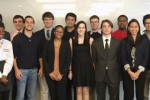
This year, ALERT and Gordon-CenSSIS had the honor of hosting 17 freshmen engineering students as participants in the ALERT and Gordon-CenSSIS Scholars Program.
After two semesters of active involvement in the program — which includes participation in an ALERT or Gordon-CenSSIS research project, K-12 STEM outreach, and Scholar meetings, seminars and activities — they completed the program on Wednesday, April 8th, 2015, when they presented their final research presentations to their faculty advisors and other members of the Scholars community. The final presentations consisted of 2-minute overviews of each Scholar’s research project, addressing their project’s overall mission and activities, their specific contributions to the project, as well as what knowledge and skills they gained.
The ALERT and Gordon-CenSSIS Scholars Program is designed to provide freshmen engineers with the opportunity to get involved in research and STEM outreach, but also focuses on building their professional development. Throughout the year, Scholars attended seminars on Leadership Skills, Research Ethics, Lab Safety, Power Point Presentation Skills, and Research Poster Building Skills.
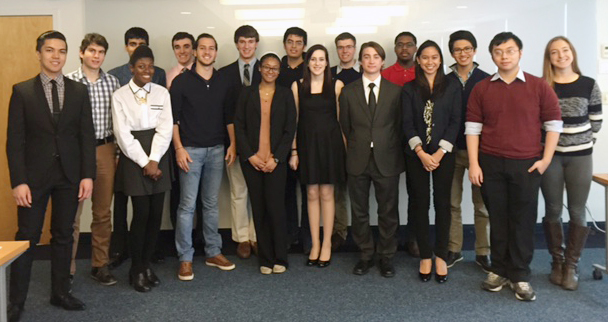
2014-2015 Scholars [L-R]: Alastair Abrahan, Paul Mykos, Neel Shah, Kasia Gibson, Jack Magrath, Luigi Annese Alizo, Carl Verch, Rachna Igwe, Michael Wong, Madeline Leger, Anthony Bisulco, Benjamin Gincley, Bryant Grey-Stewart, Alyssa Caganda, Chenyang (Eric) Liu, Kevin Wu, Julianne Kloza.
The program also aims to provide Scholars with multiple resources for mentorship and guidance. In addition to their faculty advisor, the program coordinator, and the STEM Center team, each Scholar is assigned a specific Scholar Mentor, who regularly connects with them regarding program-related activities, as well as questions or concerns related to their overall experience at NU. Scholar Mentors are undergraduate engineering students who have previously completed the Scholars program, and who apply to participate in this supporting role. As part of their involvement this spring, the Mentors each gave a presentation to the Scholars on their research, outreach and co-op experiences.
All ALERT and Gordon-CenSSIS Scholars who successfully complete the program requirements receive an NU Bookstore Voucher of up to $1,000.
The program is hosted and sponsored by the Awareness and Localization of Explosives-Related Threats (ALERT) Department of Homeland Security Center of Excellence, and the Bernard M. Gordon Center for Subsurface Sensing and Imaging Systems (Gordon-CenSSIS), a Graduated National Science Foundation Engineering Research Center.
COE students & industry partners network, make connections at 2015 ASPIRE April 10, 2015
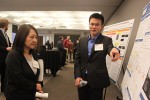
Held on April 7, 2015, the fourth Annual Student Pipeline Industry Roundtable Event, otherwise known as ASPIRE, successfully brought together two of ALERT’s key components, industrial partners and students of all levels currently involved in center research, as a means of continuing to build strong collaborations and provide networking opportunities. This year’s ASPIRE took place at Northeastern University and included students from six academic partner institutions and representatives from nine industrial collaborators. The 2015 ASPIRE was also the first to feature representation from a government agency, the Transportation Security Laboratory (TSL).
Borne out of a more than fifteen-year-long tradition that ALERT and its predecessor, the Bernard M. Gordon Center for Subsurface Sensing and Imaging Systems, has of close collaboration with industry members, ASPIRE’s mission is for industrial partners to introduce their companies, products and needs to one another, to our faculty and to our diverse student population. ASPIRE aligns with the Center’s ongoing efforts to create robust partnerships within our industrial base, while also giving students the opportunity to network as they transition through academia and into the Homeland Security Enterprise.
The 2015 ASPIRE was once again curated by the Center Industrial and Government Liaison Officer, Emel Bulat. Center Director, Michael Silevitch was on-hand to launch the event and welcome the attendees. Industry members gave 8-minute presentations, followed by 2-minute presentations made by students. ASPIRE was able to expand student participation this year through virtual presentations made by individuals that could not travel to Boston. In the afternoon, students, faculty and industry met face-to-face during a three-hour networking session. The session activities included poster presentations by students, 10-minute roundtable “get-to-know-you” discussions amongst attendees and a closing reception.
It is our hope that connections made at events, such as ASPIRE, will continue to foster alliances within the COE between students, faculty, government and industry. We expect that such collaborations will produce responses to market opportunities, including government solicitations such as Broad Agency Announcements and Request for Proposals, and eventually result in effective technology transfer.
Watch the Latest ALERT 101 January 30, 2015

ALERT is proud to present the third installment of ALERT 101. This chapter’s topic focuses on Methods of Chemical Characterization and Mitigation, and is part 1 of a 2 part series. ALERT Thrust Leaders Jimmie Oxley (Thrust 1) and Steve Beaudoin (Thrust 2) provide commentary about the crucial role of chemical characterization in the mitigation of explosives-related threats, and how ALERT research is helping first responders and security personnel to detect and eliminate threats before they can be used for malicious reasons.
Chemical characterization for the purpose of explosives detection requires ALERT researchers to classify what are explosive materials, and what are not. In the lab, researchers observe how chemicals uniquely react to stimuli, thus determining their chemical properties. For example, Differential Scanning Calorimetry subjects the chemical samples to heat, thus producing a specific reaction that can then be compared to the Explosives Database managed by the University of Rhode Island to determine if the chemical is a volatile substance.
Researchers then leverage these chemical characterizations to develop sensors that detect explosive threats. Trace analysis techniques are used to sense when chemical residues are present on surfaces of or in the air around materials by picking up small quantities of the chemicals when they are in the solid or vapor phases. One such trace method uses a polymer swab developed by Prof. Beaudoin, to sense chemicals in the solid phase on an object’s surface. This swab has individual fingers, similar in design to a toothbrush, with chemical head groups attached to the ends that attract and hold the residue to the finger. ALERT continues to advance the state-of-the-art in both solid and vapor trace technologies through their recently established Trace Explosives Sampling for Security Applications (TESSA) workshops.
As a supplement to this installment, stay tuned for ALERT 101: Basic Properties of Atoms and Molecules, coming this spring!
Inspired by the success of TED (www.ted.com) and other educational media forums, ALERT has developed the ALERT 101 video series. Each video short features different technologies and research areas that the ALERT Center engages in. We hope that these productions help educate and inform the global community on these topics in an accessible and enjoyable way.
2014 REU Program: One student’s experience as a researcher and woman in the sciences January 9, 2015

Every summer, the ALERT center selects science or engineering undergraduate students to participate in the Research Experiences for Undergraduates (REU) Program. These REU students have the opportunity to work for 10 weeks on research projects related to emerging technologies for explosives detection in one of the four ALERT research thrusts.
The 2014 summer program, which ran from June 3rd – August 7th, provided participating students with full-time work experience on ALERT research, and offered meetings and activities geared to enhance professional development. A few of the students working at NEU began their involvement in ALERT research through the ALERT Scholars Program, which provides freshmen undergraduates an introduction and gateway to engineering research on campus during the spring semester.
I sat down with 2014 REU student Amanda Figueroa-Navedo, who worked this summer with Professor Samuel Hernandez-Rivera in his Standoff Detection laboratory at the University of Puerto Rico, Mayagüez, to discuss her experience as an REU. Amanda gave insight into the active role of undergraduates in research labs, the process of conducting a collaborative research project, beginning with basic research and culminating in the publication of state-of-the-art results, and her presence as a women in the STEM field.
Teri Incampo: What year are you? What is your major and what would you like to study?
Amanda Figueroa-Navedo: I am currently in my fifth year. I started out in Chemical Engineering and I am planning to switch to Chemistry.
TI: What prompted you to change to Chemistry?
AFN: First of all, I started working with Professor Hernandez about 2 years ago. I was still in Chemical Engineering and started to take one of his courses as an elective. I was involved in that course and then became involved in research and the lab. I didn’t visualize myself in the Pharm industry or the other industries that are involved with Chemical Engineering. I wanted to be more hands on. Chemistry was it for me.
“My experience has been great, as a woman, in this lab. I am glad that this interview might motivate other women in the STEM fields to do research and to get involved in the sciences.”
TI: So working in Prof. Hernandez’s lab really made that a clear choice for you.
AFN: Yes. I am very grateful to him for giving me the chance to join his group.
TI: What is your primary research interest within Chemistry?
AFN: My primary research is the crystallization of energetic materials, which is what we have been discovering this summer. When we started this project, we had other objectives, but through our research and experimentation, we found out that we could crystallize these energetic materials in different phases. It is essentially the same molecule but the position of the groups makes it more stable or more sensitive.
TI: That’s exciting! Are you currently working on a paper?
AFN: Yes. We are currently working on paper to publish in crystallography for the American Chemical Society (ACS) journals. We are almost finished. We are still figuring out chrystallagraphical and X-ray diffraction details. We are 95% done with this work.
TI: Does this fit into the big picture of what you want to study and research? You started with one idea and it evolved. Are you wanting to continue to see where this new direction might lead you or would you want to redirect to another topic?
AFN: I want to see what else we can get from this information because the energetic material we are studying is not the only material that has these polymorphs when they crystallize. We started with RDX and we are moving onto other materials, such as TNT and HMX, which exhibit this behavior.
TI: How did you learn about the REU program?
AFN: When I started working with Prof. Hernandez, he brings students from all over the country. When I started two years ago, we had a big group of REUs. I was interested because I started working on a voluntary basis and decided to apply to be an REU for this summer.
TI: Can you explain the broader significance of this research to someone who might not be familiar with Chemistry or Engineering?
AFN: The sensitivity of these crystals is significant. When you are working with energetic materials, the types of the crystals and their morphology influences the material’s sensitivity. When you want to study crystals that are more sensitive, you would apply this to detection of energetic materials, perhaps in military applications or in airports or forensic areas. When you have less sensitive crystals, it would be helpful to desensitize these energetic materials and be able to detect them; they each have their own unique signal to vibrational techniques, such as infrared and Raman Spectroscopy. We use the spin coating technique to manipulate the crystals to be more sensitive or less sensitive, which increases the library of signals that we have gathered. This will be helpful to existing libraries in the military and airport security domains.
TI: So you are not only able to expand what you are doing within the lab but catalog the results and share the information with others working in the field.
AFN: Exactly.
TI: What challenges did you encounter when conducting your research as an REU?
AFN: One main challenge was having so much information and so little time to explain it in the final REU presentation. Crystallography is a really broad subject and during our first weeks of research, were not expecting to study it. We had to learn a lot of it in so little time. We were really excited about his project and we still have a lot more to learn.
TI: What were some of the milestones of your research?
AFN: The breakthrough was when we were able to see the beta form crystals of RDX. Beta is not extensively reported, we only found 4 works of literature that reported it. They crystallized it by evaporating the solution. We employed a new technique and found these crystals. That is one of the first milestone. The second milestone was to incorporate two techniques to validate our results. The third milestone was to incorporate computer algorithms and Chemometrics to also validate that the behavior of the chemical signatures that we found is different. We were able to present it in a more organized and simple way. Of course, I could not explain Chemometrics in the presentation but in the paper we were able to do so.
TI: Did you work with other students, fellow undergraduates or graduate?
AFN: I worked with my mentor, a graduate student named Jose Ruiz-Caballero. He was a great influence and always had an organized calendar. He was very involved in this project, especially after our main focus changed. We had Dr. Hernandez meeting with us constantly. I also had my past mentor, Dr. Pacheco who was also a main part of past projects were they have found some beta crystals by other techniques. He was a big help in identifying these crystals.
TI: How did Dr. Hernandez help you overcome some of the difficulties, as well as achieve the goals you had during your REU experience?
AFN: The first thing he said when he met with us was to organize our ideas and take out the most important parts. My mentor and I were so motivated that we had found these startling results. We were focusing on everything. So, Dr. Hernandez gave us some perspective on the main aspects of what the publication should be.
TI: Do you think you were successful in describing this broad subject and your findings during the final REU presentation?
AFN: It think it helped me to understand better because I had to summarize especially when writing the paper [we want to publish.] When started with the introduction, we had so many ideas and so many things we need to get [across] about the main points so that we could write the first paper. We wanted to include as much relevant information as we could.
TI: For the REU presentation, you were able to work through how you were explaining it and that helped to clarify how you would approach the paper.
AFN: Definitely.
TI: What has been your experience as a woman conducting research in the STEM field?
AFN: This semester we only had two women in our group. My experience has been great, as a woman, in this lab. I am glad that this interview might motivate other women in the STEM fields to do research and to get involved in the sciences.
TI: What are your goals as you look towards this coming year?
AFN: This year, as far as goals, we want to control the growth of these crystals through spin coating, as well as the crystals of other energetic materials. One of the main authors that has contributed to this field is Ilana Goldberg. Through her work, I was able to understand a lot things about crystallization of this energetic material, specifically; it was part of her dissertation. I am looking forward to doing my own graduate research on this subject, as well as prepare my thesis with this new data.
TI: What are your plans, say in the next few years?
AFN: I am planning on going to graduate school. Dr. Hernandez has been encouraging me to pursue graduate studies. After that I would probably seek a doctorate degree or pursue a job that has to do with forensic information or forensic analysis.
——————————————————————————
Amanda and her research group at UPRM have continued to make progress on this project. Throughout the fall they continued to reproduce this experiment and examine more aspects of the crystallization technique. After conducting a literature review, Amanda found that their technique has been compared to other methods without promising results in crystallography. Therefore, her research group is improving the impact of the technique by using Raman Spectroscopy to work with traces of RDX. In December 2014, the team submitted their paper for review.
[Photo (l-r): REU Student Amanda Figueroa-Navedo, Prof. Samuel Hernandez-Rivera, Graduate Student Jose Ruiz-Caballero]
Prof. Octavia Camps and Prof. Richard Radke, Presented at the Eighth ACM/IEEE International Conference on Distributed Smart Cameras December 4, 2014

ALERT researchers, Prof. Octavia Camps, Northeastern University, and Prof. Richard Radke, Rensselaer Polytechnic Institute, presented their team’s ALERT research at the 8th ACM/IEEE International Conference on Distributed Smart Cameras (ICDSC). Prof. Camps gave a keynote address, titled, “Structured Robust PCA and Dynamics-Based Invariants for Multi-Camera Video Understanding,” and Prof. Radke presented his talk, titled, “Real-World Re-Identification in an Airport Camera Network.” The conference was held on November 4th – 7th, in Venice, Italy.
ALERT Phase 2 Year 1 Annual Report Available Online! October 24, 2014
ALERT is proud to announce that the Phase 2 Year 1 Annual Report is now available for download online. This report captures the progression of the research conducted in our four thrusts: R1) Characterization & Elimination of Illicit Explosives; R2) Trace & Vapor Sensors; R3) Bulk Sensors & Sensor Systems; and R4) Video Analytics & Signature Analysis. A full bibliography of publications and presentations conducted under ALERT support follows the individual project reports. Detailed descriptions of the Year 1 activities that took place in our Research and Transition, Education, Strategic Studies, Safety, and Information Protection Programs, as well as the ALERT Phase 2 Overview and Year 1 Highlights, Infrastructure and Evaluation, and Industrial/Practitioner and Government Partnerships can also be accessed in the Annual Report.
Read MoreBritain’s Home Secretary Theresa May Visits ALERT September 17, 2014

On Monday, September 15th, Northeastern University and the ALERT COE hosted a visit from Britain’s Home Secretary, The Right Honorable Theresa May. May began her visit with a tour of two ALERT labs on Northeastern University’s campus: The Robust Systems Lab, where Prof. Octavia Camps, Prof. Mario Sznaier, and their students demonstrated ALERT’s Video Analytics Security Technology, and the Advanced Imaging Technology Lab, where Prof. Carey Rappaport, Prof. Jose Martinez-Lorenzo, and their students demonstrated ALERT’s Whole Body Imaging research.
Following her tour of ALERT’s labs, May met with Northeastern University’s President, Joseph Aoun, ALERT Director, Michael Silevitch, as well as other Northeastern officials and ALERT researchers, before serving as the keynote speaker during a panel discussion at Northeastern, which focused on combating human trafficking and modern slavery. To learn more about her visit, you can visit the Northeastern University webpage by following the “Read More” link below.
PHOTO: Professor Carey Rappaport, the ALERT Center’s deputy director, describes the center’s research projects to Britain’s Home Secretary Theresa May during a tour on Monday. Photo by Brooks Canaday.
Read MoreWelcome ALERT Summer REU (Research Experience for Undergraduates) Participants! June 2, 2014
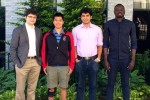
ALERT is excited to welcome our Summer 2014 REU Participants, as the program has officially starts June 2nd, 2014. Five ALERT REU participants will be working at Northeastern University this summer with Prof. Carey Rappaport, Prof. Jose Martinez, and Mr. Richard Moore. One student will be working at the University of Puerto Rico, Mayagüez with Prof. Samuel Hernandez. Participants are not only involved in ALERT research, but take part in educational and professional development activities, including giving a final research presentation at the end of the summer.
Welcome, ALERT REUs!
[Photo (l-r): Prof. Jose Martinez, REU Students: Yeehin Li (NU) and Mohit Bhardwaj (NU) and Abeco Rwakabuba (MCC ’14).]
Call for Volunteers May 1, 2014
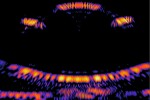
The Awareness and Localization of Explosives Related Threats (ALERT) program at Northeastern University employs an Advanced Imaging Technology (AIT) lab in the Egan building on Campus. In this lab there are technologies used to image the surface of the human body, very similar to the systems used at airports worldwide today. We are exploring combinations of imaging techniques in order to determine optimum detection of threats capabilities. The types of technologies (Video, Radar, X-ray, thermal imaging, and passive nuclear quadrapole resonance) have all been proven to be safe for human exposure. We are now in the testing phase of this research. We are calling out now for volunteers willing to be imaged by these technologies.
Research Participant FAQ
Read more details about what volunteering requires in the Informed Consent to Participate in Research FAQ.
Volunteer
Please contact us if you are interested in participating:
Professor Carey Rappaport
ALERT Thrust Lead – Bulk Sensors & Sensor Systems,
Northeastern University
[email protected]
Alyssa White
ALERT Research Consultant,
Massachusetts General Hospital
[email protected]
315-244-8178
Please note, this call for volunteers has been approved by Northeastern University’s Institutional Review Board.
ALERT and Gordon-CenSSIS Hosts the 3rd ASPIRE to promote Student and Industry Networking April 18, 2014
The 3rd ASPIRE (Annual Student Pipeline to Industry Roundtable Event), hosted by ALERT and Gordon-CenSSIS, was held on April 16th, 2014. Soon-to-be-graduating students were given the opportunity to present their research work and career goals to our ALERT and Gordon-CenSSIS Industrial Advisory Board (IAB) members. Six graduate students presented, one from Boston University (an ALERT partner institution), and five from Northeastern University.

